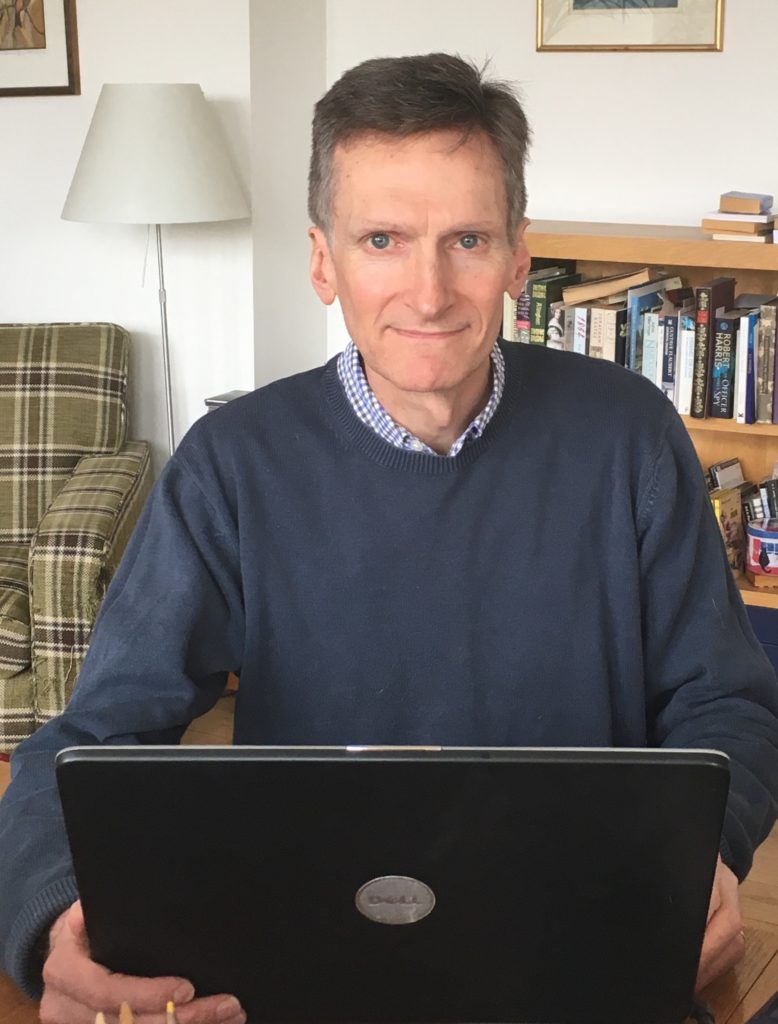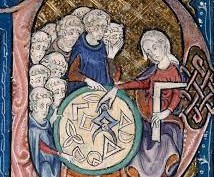7 December 2023
Men of Goodwill
Christian, Jew, Arab.
By Neil Tidmarsh

It’s the season of goodwill. Given the current shortage of this commodity in that very part of the world where those angels first announced “on earth peace, good will toward men”, it might be timely and reassuring to look at some of the men who, through mutually-beneficial collaboration rather than mutually-destructive conflict, made the most of that spirit at a remarkable but equally troubled time in history there, and whose work has helped to keep it alive ever since.
Let’s start with Adelard of Bath (1080-1152). This twelfth-century scholar and cleric was born in England but after an education in France he travelled widely throughout Europe and eventually to the Middle East. He returned to England with an extraordinary hoard of treasure from the Islamic world. This treasure wasn’t gold or silver or precious stones but books; books on science, philosophy, theology and literature by Arab and Jewish scholars.
Having learnt Arabic in Spain or Sicily during his travels, he set about translating these works into Latin and distributing them throughout the Christian West from his base in the Benedictine monastery at Bath Cathedral. His work was ground-breaking and hugely influential: he was one of the first to introduce the Arabic numeral system (including the symbol for zero) to Europe; his translation of Euclid’s Elements from an Arabic version (the original Greek version had been lost to Europe for centuries) led to the re-introduction of geometry in the West; and his translation of astronomical tables introduced algebra (an Islamic discovery) to Europe. Arabic and Jewish scholarship informed his own original works of science and philosophy, urging the study of nature at first hand: De Eodem et Diverso (On the Same and the Different); Questiones Naturales (Questions on Natural Science); and De Avibus Tractatus (Treatise on Birds).
But Adelard wasn’t unique in his open-minded pursuit of knowledge from beyond the bounds of his own faith and culture at this time, and Bath wasn’t the only centre for Islamic studies in twelfth-century Christendom. There were similar and indeed bigger and more active entrepots of Eastern scholarship in northern Spain, Sicily, Northern Italy and Southern France, places close to the frontier with the Islamic world and where there were sizeable Jewish communities – the work of translating, editing, developing and commenting upon Arabic texts (and ancient Greek texts which had been preserved in the Islamic eastern Mediterranean but lost in the West) was largely undertaken by Jewish scholars, who straddled both worlds, Christian and Islamic, West and East.
The Spanish city of Toledo was perhaps the greatest of these international clearing-houses of knowledge. Scholars came from all over Europe – from Italy, Greece, France, Germany, England and the Balkans – to take part in its activities and to gather its fruits. Daniel Morley (1140-1210) from Norfolk, following in the footsteps of Adelard of Bath, went to Toledo and for some years studied “the wiser masters of the world” there before returning to England with a library of Greek and Arab books.
And what of the originators of this knowledge, the men who wrote these texts which so excited adventurous minds from other cultures and religions? The Islamic world of the early Middle Ages, spanning the Middle East and north Africa and southern Spain, sat on the intellectually-fertile territory of older civilisations, in particular of Judaism, of Rome and especially of Greece. It sent deep roots down into the nourishing soil of the Persian, Babylonian, Judaic, Hellenic, Classical and Late Antique worlds (and into neighbouring India), preserving their texts, absorbing their knowledge and learning from them to make its own discoveries in science, philosophy, astronomy, mathematics, medicine, etc.
The astronomical tables translated by Adelard of Bath were the work of Al Khwarizmi (780-850), the head astronomer and director of the House of Wisdom, the Great Library of Baghdad. His treatise on algebra, The Compendious Book on Calculation by Completion and Balancing, established him as the father or founder of algebra (his term – al jabr meaning ‘completion’ or ‘rejoining’) as a separate branch of mathematics; the Latin translation made by the Englishman Robert of Chester in 1145 was the standard text-book used in European universities for the next four centuries. Another of his works on mathematics not only introduced the decimal point and Indian numerals but also gave us the word ‘algorithm’ (a word trendier than ever in our twenty-first century world), which is the Latinised version of his name. He also wrote on trigonometry (producing accurate sine and cosine tables and the first table of tangents), on the astrolabe and the sundial, on the Hebrew calendar and on geography and cartography (he revised Ptolemy’s Geography, correcting the longitudes and latitudes of places mentioned, and directed projects to determine the circumference of the earth and to produce a map of the world). His work on mathematics was continued by Abu Kamil (850-930), known as ‘the Egyptian calculator’.
Ibn Sina (980-1037), known to the west as ‘Avicenna’, attained almost mythical status in medieval Europe (the late fourteenth century Chaucer refers to him frequently and reverentially, clearly hoping that such name-dropping will lend intellectual kudos to his own work!). He was born near Bokhara and became one of the greatest philosophers and the greatest physician of the Middle Ages, writing mostly in Arabic rather than Persian. He was physician to numerous sultans and his gigantic medical encyclopaedia The Canon of Medicine was translated into Latin by Gerard of Cremona in Spain during the twelfth century. It returned Aristotle’s and Galen’s medical ideas to the west long after they had been lost there, and remained the standard medical text for universities and doctors everywhere right up to modern times. He wrote almost five hundred works of philosophy, science, religion and poetry, more than two hundred of which survive.
Solomon ben Yehuda ibn Gabirol (1020-1070), known as ‘Avicebrón’, was a Jewish poet and philosopher born in Malaga in Moorish Spain. His most famous work, translated from Arabic into Latin in the twelfth century as Fons Vitae, the Fountain of Life, was a seminal piece of neo-Platonism which had a great influence on the scientific thought of the Franciscans. His poetry became part of the mystical tradition of the Kabbala.
Ibn Zohr (1070-1162), or ‘Avenzoar’, was a great physician like Avicenna. He was born in Seville, in Moorish Spain, at the other end of the Islamic world from Avicenna’s Persia. He introduced a novel approach – empirical and rational – to medicine. His work built on Galen and Hippocrates but he was also a pioneering surgeon. He was the first to diagnose and describe such conditions as kidney stones and pericarditis and to undertake experimental operations such as tracheotomies.
Ibn Bajja (1085-1138) or ‘Avempace’ was an Arabic scientist, philosopher and poet born in Zaragoza in Moorish Spain. His commentaries on Aristotle were one of the first ever written and, when translated into Latin, helped to reintroduce that Greek philosopher’s ideas back into western Europe. His work on astronomy and physics influenced Galileo and other figures of the European Renaissance.
Ibn Rushd (1126-1198) or ‘Averroes’ was an Arabic philosopher (possibly the greatest Arab philosopher), jurist and physician born in Cordoba in Moorish Spain who also wrote commentaries on Aristotle and whose work was even more influential in the West where he was known as ‘The Commentator’ and ‘the Father of Rationalism’.
Moses ben Maimon (1135-1204) or ‘Maimonides’ was a Jewish philosopher also born in Cordoba. He moved to Egypt and lived in Cairo where he became Saladin’s physician and the head of the Jewish community. He wrote a commentary in Hebrew on the Mishna (the Jewish code of law) but his other works were written in Arabic (including the Guide to the Perplexed which urged a reconciliation of Judaism and Greek philosophy). He was one of the most influential thinkers of the Middle Ages, across all three faiths.
This discovery of Jewish and Arabic scholarship happened at a remarkable time in Europe. Historians have dubbed it ‘the Twelfth Century Renaissance’ or ‘the Long Twelfth Century’. It was a time of open minds and open frontiers. Scholars, merchants and pilgrims travelled widely. Trade and commerce flourished. The climate was good, harvests were plentiful, the population expanded dramatically, towns grew and more and more land came under the plough. It was the time of the troubadours, of Provencal courtly love, of chronicler-monks making accurate records of their age. But it was also a time of violence, of the Crusades, of armed conflict between the elites of Christendom and of the Islamic world (and among themselves). Jews, as ever, were subject to intermittent persecution. And the activities of the open-minded, liberal and enlightened scholars, the men of goodwill (the handful mentioned above are just a few examples among many), were not without peril; they all risked censure or punishment for trafficking in dangerous ideas.
The long twelfth century had to come to an end sooner or later, however, and a very abrupt end it was too. The climate deteriorated dramatically in the thirteenth century, apocalyptic storms and floods swept away whole towns, harvests failed, the population stopped growing, towns stopped expanding. Violence, warfare and piracy increased. The Mongol invasions had a devastating effect on the Islamic world. Minds and frontiers closed. In all three faiths – Christianity, Judaism and Islam – belief hardened into dogma which intolerant religious authorities guarded jealously, condemning the new or the unorthodox or the foreign as dangerous heresies to be ruthlessly crushed. When the Black Death struck in the fourteenth century, it was all the more dreadful for finding the population already weakened by malnutrition. Two thirds of the population of Europe perished. The terror it caused only hardened the intolerance of religious authorities and strengthened their determination to stamp out the unorthodox and the ‘heretical’.
The European Renaissance, which looked just around the corner in the 1100’s thanks to the work of the men of goodwill, had to wait another three or four centuries. But when it did occur, it was thanks in no small part to those open-minded scholars of the Long Twelfth Century, the Jewish, Arabic and Christian men of goodwill who worked together across cultural boundaries for the benefit of mankind while all around them others fought each other in mutually destructive combat. Their work did eventually bear fruit, and that must be a valuable and reassuring lesson, a vital encouragement to today’s men of goodwill who must be finding it hard not to despair in that part of the world where the season of goodwill was first announced two thousand years ago.


